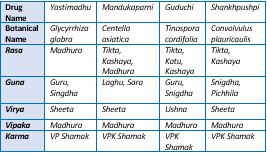Review article on the role of Medhya Rasayana : Enhancing the Intellectual Power
Keywords:
Medhya Rasayana, Ayurveda, Medha, Dhi, Dhriti, Smriti, NeurotransmittersAbstract
In this period of global competitiveness, the spirit of competition is instilled in each individual from childhood. Even to get entrance to a reputable nursery school, the kid must pass several tests. Then, for success in higher education, such as primary, secondary, and post-secondary education, continual vigilance and intellectual sharpness are essential. The capacity to retain what has been learned and to recall it at the appropriate time and in the right place is the only way to succeed at every level. In such circumstances, a person's grasping and retention abilities are important. According to Ayurveda both Vata and Kapha Dosha must be harmonized in order to increase Medha or Intellectual. Memory is improved when Vata and Kapha are together. Pitta Dosha (fire element) is important for increasing sharpness and IQ. To accomplish this objective by balancing the Tridosha, Ayurveda refers to both single medications and a class of pharmaceuticals are named as "Medhya Rasayanas" in the Charaka Samhita. They are Mandukaparni Swarasa (Centella asiatica), Yastimadhu Churna (Glycirrhiza glabra), Guduchi Swarasa (Tinospora cordifolia), and Shankhapushpi Kalka (Convolvulus pluricaulis). Mandukparni Swaras, Yashtimadhu Churna with Ksheer, Guduchi Swaras, and Shankhapushpi Kalka are anxiolytic, disease-relieving, and boosters of strength, Agni, complexion, voice and Medhya. Medhya Rasayana medicines are used to suppress and treat mental illnesses in people of various ages. These medications improve the ability to acquire (Dhi), retain (Dhriti), and remember information (Smriti). Medhya Rasayana medicines are used to prevent and cure mental disorders and health Promotion in people of all age’s groups.
Downloads
References
Chaudhari K, Murthy ARV (2014) Effect of rasayana on mental health-a review study. International Journal of Ayurveda and Alternative medicine 2: 1-7.
Contribution of Panchakarma in management of Dementia (Life Style Disorder) Punam G. Sawarkar, Gaurav Sawarkar, Ashwini Meghe Ayurlog: National Journal of Research in Ayurved Science-2017 ;(5) (Ayur Kaushalya special issue);807-817
Acharya Vagbhata, Astanga Hridaya, Sutrasthana 12/4-5, Vidyotini Commentary by Atrideva Guptapa, Chaukhamba Prakashan, 2008, Page no.120
Acharya Vagbhata, Astanga Hridaya, Sutrasthana 12/5, Vidyotini Commentary by Atrideva Guptapa, Chaukhamba Prakashan, 2008, Page no.120
Pandit Sarangdhara, Sarangdhara samhita, Purvakhanda 5/50, dipika tika, edited by Brahmananda Tripathi, Chaukhmbha Prakashana, Varanasi, 2006, Page no.61
Acharya Charaka, Charak Samhita, Sutrasthana 18/51, Ayueveddipika commentary by Chakrapanidatta edited by Vaidya Yadavji Trikamji Acharya, Chaukhamba Prakashan, 2009, Page no.109
Agnivesha, Charaka Samhita, Ayurveda Dipika Commentary of Chakrapanidatta, translated by; Dr. Ram Karan Sharma and Vaidya Bhagwan Dash, Chaukambha Orientalia, Varanasi, Reprint Edition : 2000, Volume 3, Pp : 632, chikitsasthana, Ch no : 1(3), Sloka no :30-31
Sharma Priyavrat. Dravya Guna Vigyan. Varanasi; Chaukhamba Bharti Academy. Vol.I .2002. page no. 249.
https://www.ncbi.nlm.nih.gov/pmc/articles/PMC3459 457
Dravyaguna – Vijnana Vol.2 [Vegetable drugs] Prof. P.V. Sharma ;chapter 1[MedhyadiVarga] ChukhambhaBhartyacademy,varanasi 2013. p 3-14.
Singh AK, Gupta AK, Manish Singh PK (2014) Rasayana therapy: A magic contribution of Ayurveda for healthy long life. Int J Res Ayurveda Pharm 5: 41- 47.
Beg S, Swain S, Hasan H, Barkat MA, Hussain MS. Systematic review of herbals as potential anti-inflammatory agents: Recent advances, current clinical status and future perspectives. Pharmacognosy Rev 2011; 5:120-37.
Agnivesha. Charka Samhita with Chakrapani’s Ayurveda Deepika Tika. Acharya YT, editor. Varanasi: Chaukhamba Sanskrit Samsthana;1994. p. 385.
Sharma PC, Yelne MB, Dennis TJ. Database on Medicinal plants used in Ayurveda and Sidha. Vol 1. New Delhi: CCRAS, Dept. of AYUSH, Ministry of Health and Family Welfare, Govt. of India; 2005. p. 265-6.
Ramanathan M, Sivakumar S, Anand Vijayakumar PR, Saravanababu C, Rathinavel Pandian P. Neuroprotective evaluation of standardized extracts of Centella asiatica in monosodium glutamate treated rats. Indian J Exp Biol 2007; 45:425-31.
Anbuganapathi GA, Synergetic effect of Vallarai and Brahmi on learning ability of albino mice and school children. Ootacamund: Paper presented at the International Seminar on Recent Trends in Pharmaceutical Sciences; 1995. p. 18-20.
Mohandas Rao KG, Muddanna Rao S, Gurumadhva Rao S. Centella asiatica (L.) Leaf Extract Treatment during the Growth Spurt Period Enhances Hippocampal CA3 Neuronal Dendritic Arborization in Rats. eCAM 2006; 3:349-57.
Pandey G. Dravyaguna Vijnana Part II. Varanasi: Chaukhamba Krishnadas Academy; 2004. p. 462 8.
Hikino H. Recent research on oriental medicinal plants. In: Wagner H, Hikino H, Farnsworth NR, editors. Economic and Medicinal Plant Research. Vol. 1. London: Academic Press; 1985. p. 53.
Gold PE. Role of glucose in regulating the brain and cognition. Am J Clin Nutr 1995;61 Suppl: 987 95.
Dhingra D, Parle M, Kulkarni SK. Memory enhancing activity of Glycyrrhiza glabra in mice. J Ethnopharmacol 2004; 91:361 5.
Pohanka M. Acetylcholinesterase inhibitors: A patent review (2008 present). Expert Opinther Pat 2012; 22:871 86.
Bhavamishra, Bhavaprakasha Nighantu, Gudoochyaadi Varga - 3/9, Vidyotini Hindi Commentary edited by Chunekar KC, Chaukhamba Prakashan, Varanasi, 2006; 269.
Chakravarthi KK, Avadhani R, Narayan RS. Eff ect of root extract on learning and memory in Wistar albino rats. Int J Biol Med Res 2012;3:2059-64.
Agarwal A, Malini S, Bairy KL, Rao MS. Effect of Tinospora cordifolia on learning and memory in normal and memory deficit rats Indian Journal of Pharmacology, 2002; 34: 339-349.
The Ayurvedic Pharmacopoeia of India. Part I. Vol. 2. Delhi: Controller of Publications, Civil Lines. 1999; p. 155.
Kumar A, Kulkarni SK. Protective effect of BR-16A, a polyherbal preparation against social isolation stress: Possible GABAergic mechanism. Phytother Res 2006;20:538-41.
Rajagopalan V. Seminar on research in Ayurveda and Sidha. New Delhi: CCRAS; 1995.
Sanjeev Kalra. A study on the effect of Shankhapushpi compound and Satwavajaya Chikitsa in Chittodvega (generalized anxiety disorders). Dept. of Post Graduate studies in Manasa Roga, SDM College of Ayurveda and Hospital. Hassan, Rajiv Gandhi University of Health Sciences, Karnataka, 2006.
Parsania S. A clinical study on the role of Jaladhara and Shankhapushpi (Convolvulus pleuricaulis) in the management of Chittodvega (anxiety disorder). Jamnagar: Dept. of Kayachikitsa, IPGT and RA, Gujarat Ayurveda university; 2001.
Kumar V. Potential Medicinal Plants for CNS Disorders: An Overview. Phytother Res 2006;20:1023-35.















